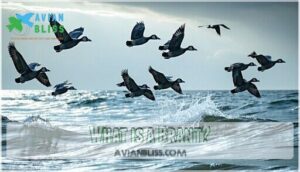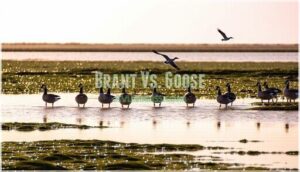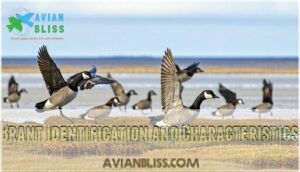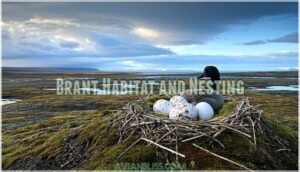This site is supported by our readers. We may earn a commission, at no cost to you, if you purchase through links.
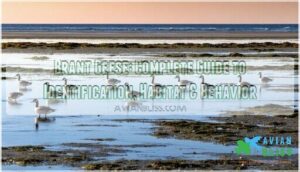
These coastal specialists sport black heads with distinctive white neck patches and short, stubby bills perfect for nibbling marine vegetation.
Unlike their inland cousins, brant stick to saltwater year-round, following tidal rhythms as they graze on eelgrass that makes up 80% of their diet.
They nest exclusively in Arctic tundra before setting out on marathon migrations spanning thousands of miles.
Three species exist: Atlantic, Black, and Gray-bellied brant, each adapted to specific coastal regions where most waterfowl fear to paddle, making them well-suited to their coastal environment.
Table Of Contents
Key Takeaways
- You’ll spot brant geese by their compact size (2-5 pounds), black heads with white neck patches, and stubby bills that set them apart from larger Canada geese
- You can’t find them in freshwater during non-breeding season—these coastal specialists stick exclusively to saltwater environments where they graze on eelgrass that makes up 80% of their diet
- You’ll witness incredible endurance during their migrations, with Pacific brant flying non-stop for 3,000 miles in 55-60 hours from Alaska to Baja California
- You’re seeing a vulnerable species that faces mounting threats from coastal development and climate change, making habitat protection crucial for their survival
What is a Brant?
Brant geese represent one of nature’s most specialized waterfowl species. These compact arctic birds belong to the goose relatives family but stand apart with unique wildfowl characteristics.
Nature’s most marine-adapted geese, thriving where saltwater meets sky
Unlike their larger cousins, brant geese have adapted to coastal marine environments rather than freshwater habitats.
Three distinct Brant Species exist: Atlantic Brant with mottled bellies, darker Black Brant from western regions, and Gray-bellied Brant. Their bird classification places them among the most maritime-adapted waterfowl types, spending winters exclusively in saltwater environments.
What sets brants apart? They’re the only geese that avoid freshwater during non-breeding seasons, making them true sea geese.
Brant Vs. Goose
Understanding what makes a brant goose special requires comparing it to other waterfowl species.
These compact birds break the mold of typical goose behavior and appearance.
Size Comparison reveals brant geese weigh just 2–5 pounds, making them roughly 25% the mass of Canada Geese.
Their stubby bill shape and short neck create a distinctly different silhouette from their long-necked relatives.
| Feature | Brant Goose | Canada Goose |
|---|---|---|
| Weight | 2-5 lbs | 8-14 lbs |
| Neck Length | Short, compact | Long, extended |
| Bill Shape | Stubby, small | Large, prominent |
| Feather Color | Black head/neck, white necklace | Brown body, white cheek patch |
| Habitat Overlap | Coastal saltwater only | Freshwater and land |
Migration Patterns showcase another key difference.
While Canada Geese form organized V-formations, brant migration involves compact flocking without structured flight patterns.
Goose Habitat preferences separate these species completely—brants stick to tidal estuaries, feeding on eelgrass and sea lettuce, while other goose species graze widely on terrestrial grass and crops.
The brant’s unique characteristics can be further understood by studying brant goose habits in their natural environment.
Brant Identification and Characteristics
Spotting a brant goose becomes second nature once you know their signature features. These compact waterfowl measure 22-25 inches long with a distinctive Brant Size that falls between mallards and Canada geese. Their Wing Span reaches 41-43 inches, making them surprisingly agile fliers.
The Bill Shape is remarkably stubby and short, perfectly adapted for grazing marine vegetation. Body Color varies dramatically across subspecies – Atlantic brants sport mottled brown-and-white bellies, while Black brants display darker plumage throughout their bodies.
Feather Patterns create striking contrasts: jet-black heads and necks highlighted by crisp white throat patches. Their bodies showcase rich brown tones with lighter edges that provide excellent camouflage in coastal environments.
Bird identification becomes easier when you focus on these key bird characteristics:
- Shortest tail among all goose species
- Jet-black eyes that appear alert and intelligent
- White neck patches that vary in size between individuals
- Compact build with relatively short necks
- Sexual dimorphism – males typically larger than females.
These brant behavior markers make field identification reliable for any birding enthusiast. Understanding the basic bird traits is essential for accurate identification of brant geese in their natural habitats.
Brant Habitat and Nesting
You’ll find Brant geese nesting exclusively in the harsh Arctic tundra, where they build simple ground nests lined with down, moss, and nearby vegetation.
These coastal specialists choose nesting sites near wetlands and sedge meadows, creating a cozy nursery that can withstand the brutal Arctic conditions while keeping their precious eggs safe from predators.
Nest Placement
These ground-nesting birds choose elevated tundra sites like hummocks and dry mounds for ideal nest location.
Their ground nests utilize natural vegetation cover from tall grasses and moss.
Brant goose pairs select spots with panoramic views to monitor predators while staying near freshwater sources.
Strategic nest placement on islands and coastal flats maximizes safety during brood rearing phases.
Nest Description
These architectural marvels showcase impressive nest materials including moss, lichens, and coastal grasses.
The nest shape forms a shallow depression measuring 20-25 centimeters across.
Soft down feathers create insulation for the typical clutch size of 3-5 eggs.
Each ground nest represents careful site selection, with females constructing these bird habitat sanctuaries that support successful avian reproduction in harsh Arctic conditions.
Nesting Facts
During Arctic summers, Brant Goose pairs establish Ground Nests on coastal tundra for Goose Reproduction.
The Incubation Period lasts 22-24 days, with females handling duties alone.
Key Nesting Facts include:
- Egg Laying produces 3-5 eggs per clutch in late May
- Chick Development enables flight within two months of hatching
- Brood Rearing occurs near nutrient-rich marshes and mudflats
Understanding Brant Nesting habits is essential for conservation efforts.
Brant Diet and Feeding Habits
Specialized feeders, Brant geese demonstrate remarkable avian dietary adaptations that set them apart from other waterfowl. These goose dietary requirements center around a saltwater diet dominated by marine vegetation. Eelgrass Consumption forms the backbone of their nutrition, comprising over 80% of their annual caloric intake.
Their Foraging Behavior follows tidal patterns, with peak activity during low tide when Aquatic Plants become accessible. You’ll observe these efficient grazers using specialized bills to nip submerged vegetation rather than dabbling like typical waterfowl. Sea Lettuce serves as their primary backup food source when eelgrass becomes scarce.
Understanding a goose diet plan is essential for maintaining a healthy flock.
| Food Source | Consumption % | Peak Season |
|---|---|---|
| Eelgrass | 80% | Year-round |
| Salt marsh grasses | 15% | Winter/Spring |
| Sea lettuce | 5% | Winter shortages |
| Seeds/tubers |
Brant Behavior and Migration
Brant geese showcase remarkable Migration Patterns that span thousands of miles twice yearly.
These waterbird species navigate from Arctic breeding grounds to coastal wintering areas using established Flight Routes like aerial highways.
Pacific Brant often complete non-stop flights of 3,000 miles in 55-60 hours—that’s flying from Alaska to Baja California without touching down.
These arctic nomads fly non-stop for 3,000 miles, proving that true wanderers never need to rest
Their Flocking Behavior reveals sophisticated Social Structure.
Family groups stick together throughout migration, maintaining bonds that last beyond the breeding season.
You’ll see them flying in V-formations or straight lines, constantly communicating through distinctive calls that sound like distant crane conversations.
Brant Goose populations demonstrate impressive Habitat Adaptation during these journeys.
They rotate leadership within flocks to share energy costs and time arrivals perfectly with food availability at stopover sites.
Their bird migration patterns follow photoperiod triggers, with spring departures beginning mid-April and fall migrations starting September through November.
These bird behavior patterns and goose migration routes represent millions of years of evolutionary fine-tuning.
Brant Conservation and Human Impact
Brant Goose populations face mounting Environmental Threats from Climate Change and Human Disturbances. Coastal development impacts 60% of wintering sites, while oil spills reduce Arctic populations by 5-10% annually.
Conservation Efforts show promise through Habitat Protection initiatives, reducing hunting mortality from 25,000 to 8,500 birds since 1997. Wildlife Conservation programs restored Atlantic wetlands, boosting local populations 12%.
Success in bird conservation requires balancing coastal ecosystems protection with sustainable management across their range. Effective conservation products are essential for supporting these initiatives and promoting the well-being of Brant Geese.
Frequently Asked Questions (FAQs)
What is a brant goose?
You’ll recognize these compact waterfowl by their black heads, stubby bills, and distinctive white throat patches.
They’re marine specialists, feeding on eelgrass in coastal bays and estuaries while migrating thousands of miles between Arctic breeding grounds and temperate coastlines, which makes them distinctive creatures.
What is a black brant?
Imagine this coastal wanderer as nature’s dark knight soaring above saltwater marshes.
You’ll spot a Black Brant by its darker plumage compared to other subspecies.
This western North American variant sports deeper gray-brown coloring and prefers Pacific coastlines from Alaska to Baja California.
What does Branta mean?
You’ll find that "Branta" comes from the Old Norse word "brandgás," meaning burnt goose.
This scientific genus name refers to the dark, charcoal-colored plumage that makes these waterfowl look fire-scorched against winter skies.
What is a Brant Gee?
Pacific Brant can migrate 3,000 miles non-stop in just 55-60 hours.
You’ll spot these compact geese by their black heads, white throat patches, and stubby bills along coastal waters feeding on eelgrass.
Is Brant a good fusion unit?
You’re thinking fusion units from Dragon Ball, but Brant’s a wild goose species, not an anime character.
These compact Arctic birds can’t power up or transform—they’re just excellent at long-distance coastal migrations, and it’s notable that they are wild.
How do you use Brant?
You’ll use Brant by observing their coastal foraging patterns during low tides.
Watch them graze on eelgrass and sea lettuce in estuaries, noting their compact size and distinctive white neck patches for proper identification.
This will help you understand their behavior and identify them correctly based on their distinctive features.
What is a brant?
A brant is a small, compact seagoose you’ll recognize by its black head, neck, and stubby bill. These coastal specialists migrate between Arctic breeding grounds and temperate shorelines.
What is a brant in English?
Surprisingly enormous in their Arctic adventures, you’ll discover a brant is a compact sea goose.
These dark-headed waterfowl sport white throat patches and specialize in saltwater vegetation.
They’re smaller than Canada geese but perfectly adapted for coastal living.
What is the difference between a goose and a brant?
Geese are a broad family of waterfowl, while you’ll find brants are a specific compact goose species.
Brants have shorter necks, stubbier bills, and distinctive black heads with white throat patches compared to typical geese.
Can you eat Brant geese?
Yes, you can legally hunt and eat Brant geese during designated seasons with proper licenses. They’re considered excellent table fare with rich, flavorful meat that’s prized by waterfowl hunters.
Conclusion
Observing their coastal habits, studying their migration patterns, and protecting their saltwater sanctuaries—these actions guarantee brant populations thrive for generations.
You’ve learned how these remarkable seabirds navigate thousands of miles between Arctic breeding grounds and temperate wintering areas.
Their specialized diet of eelgrass and marine vegetation makes them vulnerable to habitat loss and climate change.
By supporting wetland conservation efforts and monitoring local populations, you’ll contribute to brant research and protection initiatives that preserve these unique coastal specialists.
- https://en.wikipedia.org/wiki/Brant_(goose)
- https://www.eastsideaudubon.org/corvid-crier/2019/9/2/brant
- https://pacificbirds.org/2017/01/pacific-brant-rely-on-key-coastal-habitats/
- https://www.allaboutbirds.org/guide/Brant/lifehistory
- https://olympicpeninsulaaudubon.org/dungeness-data/the-story-of-brant

